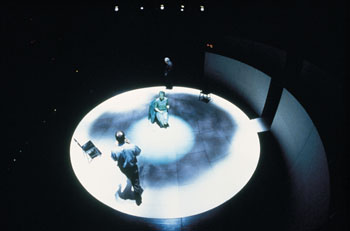Now playing to full houses in London’s theatreland is Copenhagen, a fascinating new play that imagines a dialogue between the ghosts of quantum pioneers Niels Bohr and Werner Heisenberg.

The play Copenhagen shows that physics, in the hands of talented British playwright and author Michael Frayn, can be entertainment.
However, few theatregoers are pulled to the box office by the promise of an evening about physics: it is Frayn’s name that packs them in. With an International Emmy Award in 1990, several Best Comedy Awards and Play of the Year, audiences know that he delivers the goods.
In the 1998 harvest of theatre awards, Copenhagen was judged Best Play by the London Evening Standard and Best New Play by the Critics’ Circle, and was nominated for a 1999 Olivier Award.
It is stark theatre no scenery, three chairs as the only props and a cast of three: Neils Bohr, his wife Margrethe and Werner Heisenberg on stage for the entire performance.
The focus of the “action” is a recreation of what happened in 1941 when Heisenberg went to Copenhagen to meet Bohr. Shortly afterwards, Bohr fled to Sweden and then the UK, eventually turning up in Los Alamos, where he became a father-figure for the Manhattan project.
Heisenberg played an influential role in the much more modest German wartime effort. Did they exchange physics information in Copenhagen? Did they try to influence each other in any other way? Suspecting that Bohr was in contact with the Allies, did Heisenberg try to dupe them by giving Bohr bad information? Did Bohr try to dupe the Germans by fooling Heisenberg? Who knows? Nobody, but Frayn tries to guess.
Rather than a scientific “whodunit?”, the play is more of a “who did what?, with accusations and counter accusations coming from all three sides. As well as the wartime nuclear fission developments, in the second half of the play the “plot” overflows into basic physics for good measure.
Margrethe (admirably depicted by Sara Kestelman) is portrayed as omniscient. Why did Frayn not depict instead Carl von Weizsäcker, who accompanied Heisenberg to Copenhagen and whose pronouncements on physics would have been more authoritative than those of Mrs Bohr? Probably because the idea is to recreate what happened when Heisenberg went to talk with Bohr at his house, not in his physics institute. Whatever else was on his mind in 1941, Heisenberg cared deeply about Bohr.
David Burke’s Bohr is visually evocative. In the BohrHeisenberg stage duel, both characters are portrayed as strong and assertive in their dialogue, but in real life their assertiveness and obstinacy lay deeper than their oral skills.
For such a stark presentation, director Michael Blakemore and lighting designer Mark Henderson have pulled out all of the stops.
Frayn says that his interest was whetted by reading Thomas Powers’ book Heisenberg’s War and David Cassidy’s biography of Heisenberg, Uncertainty.
Science communication is still in its infancy, but full marks should be awarded to Frayn for making compelling theatre out of physics. He deserves special recognition for such a heroic undertaking. The result is certainly riveting and accurate, although scientific nit-pickers will occasionally wince. In places the physics is painted too thickly, blinding the audience with science. But that is by the way.








